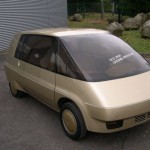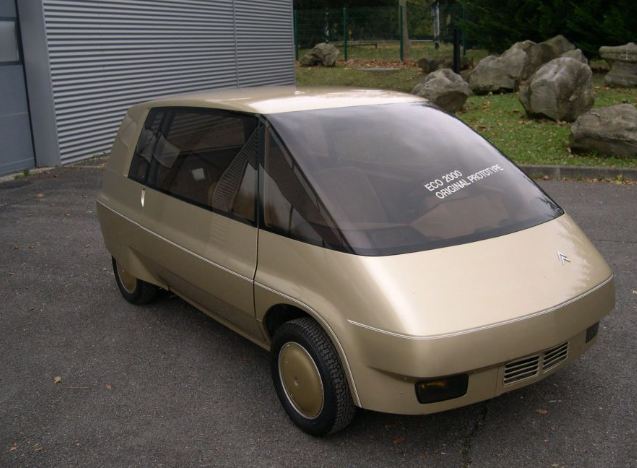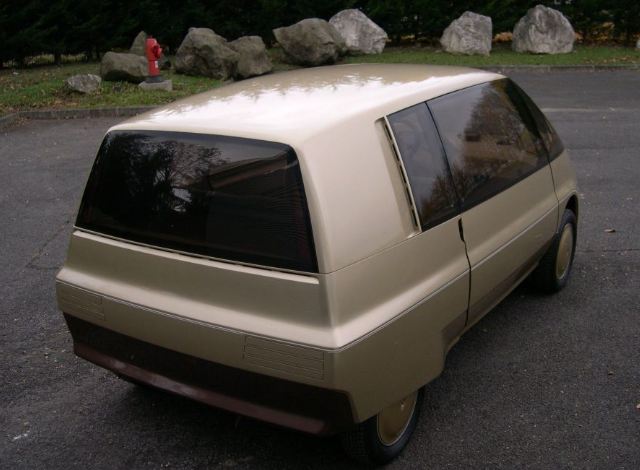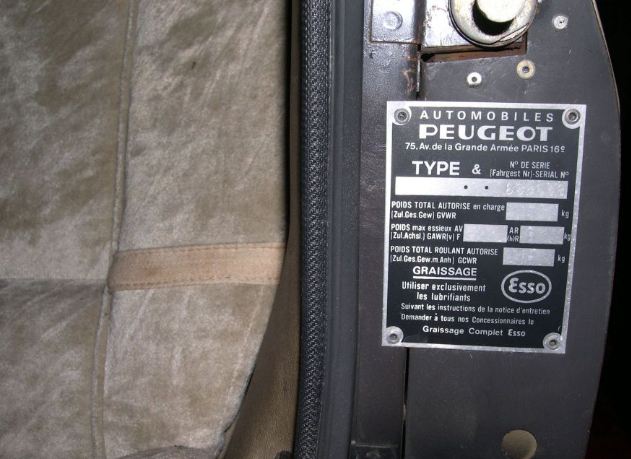
(English below, Francais au-dessous)
Eine ganz besondere Auktion wird in wenigen Tagen im Rahmen der Retromobile 2014 in Paris stattfinden – der Auktionator “Artcurial”, bekannt u.a. für die Versteigerung von historischen Fahrzeugen und Automobilia, bietet im Auftrag des Conservatoire Citroën, der historischen Werkssammlung des Unternehmens Automobiles Citroën, am 7. Februar 2014 den Prototyp “ECO 2000” (genaugenommen den ersten der drei bekannten Prototypen, Bez. “SA 103”) zum Verkauf an.
Die Hintergrundinformationen zum Fahrzeug, unsere Übersetzung der Artcurial-Seite:
Die Ölkrise der 1970er Jahre hinterliess ihre Spuren – dem Kraftstoffverbrauch in Automobilen rückte in den Vordergrund, und das nicht nur aus vertrieblicher Perspektive, sondern auch aus politischen Gründen, da die Verringerung des Energiebedarfs in vielen Ländern zum nationalen Ziel auserkoren wurde.
Im Jahr 1981 wurde das “ECO 2000” Programm seitens Peugeot und Citroën initiiert, und kulminierte im Jahr 1986 mit der Entwicklung eines Fahrzeugs, das nur noch im Schnitt von 3 Liter Kraftstoff pro 100km verbrauchte. Dieses Projekt wurde zu 50% durch die französische Regierung gefördert, und rund einhundert Ingenieure von Peugeot und Citroën waren an dem Forschungsprogramm beteiligt. Die Lastenheft legte u.a. fest, dass “alle technischen Vorurteile zu Beginn beiseite gelegt werden sollen, und man komplett neu in allen Richtungen die Erforschung der unterschiedlichsten Lösungen ansetzen sollte.”
Die Studien führten zu insgesamt 4 entwickelten Prototypen: der SA 103, SA 109, SA 117 und SL 10. Der letzte Prototyp wurde im Jahr 1985 gebaut und erreichte einen Verbrauch von 2,4 Litern auf 100 km bei 90 km/h, und im Durchschnitt damals 3 Litern – das Ziel wurde erreicht!
Der hier nun angebotene Prototyp, Bezeichnung SA 103 – der erste in der Reihe – wird direkt von Citroën Heritage (Conservatoire, Anm. der Amicale), angeboten, die sich entschieden haben, sich von ihm trennen. Citroën beschreibt diesen Prototyp wie folgt: es sei die “erste Synthese der bis dahin durchgeführten theoretischen Arbeiten, dessen Fokus in erster Linie auf Gewichtsreduktion und Ästhetik ausgelegt war. Der Wunsch, nicht von vornherein alle möglichen Optionen für den Motor auszuschließen, wird durch die Verwendung des sehr allgemeinen Begriffs “Antrieb” in der Kommunikation ersichtlich. Um Zeit zu sparen, wurde zunächst der flache Zweizylindermotor wurde beibehalten.”
Das Auto wiegt nur 430 kg, mit einem cW-Wert von 0,267 und Kraftstoffverbrauch von rund 3,5 Liter pro 100 km. Der 704-ccm-Motor entwickelt 26 DIN-PS und brachte den Prototyp auf eine Höchstgeschwindigkeit von 140 km/h.
Mit diesem Prototyp, das die Bedenken zur unendlichen Verfügbarkeit von Energie bereits vorwegnimmt, bietet dieser Citroën ECO 2000 eine einzigartige Gelegenheit, einen Prototyp zu erwerben, der ein Zeugnis der damaligen Hochtechnologie-Forschung ist und in den geheim gehaltenen Entwicklungs- und Designlabors eines Herstellers gefertigt wurde. Es ist eine einzigartige Gelegenheit für Sammler, die gerne in dieses Projekt investieren wollen, den Prototyp mit seinem typischen 80er-Jahre Styling wieder behutsam funktionsfähig zu machen und auf die Straße zu bringen. Das Fahrzeug kann in Frankreich mit einer “carte grise de collection” zugelassen werden.
Die Versteigerungs-Infos bei Artcurial (engl./frz.):
http://www.artcurial.com/en/asp/email_lot.asp?salelot=2400+++++330+&refno=10469269
Weitere Infos auch hier bei Citroenet – Julian Marsh:
www.citroenet.org.uk/prototypes/eco2000/eco-2000.html
Nach den erschreckenden Informationen über die Versteigerung des Heuliez-Conservatoires im Jahr 2012 (die Amicale berichtete) haben wir den Hersteller in Frankreich um eine Stellungnahme gebeten, um zu erfahren, warum die Versteigerung einzelner Elemente des Firmenerbes notwendig ist und welche Strategie PSA Citroën verfolgt, insbesondere da die nationale Kooperationsvereinbarung zwischen Citroën, Amicale und den Clubs in Deutschland als eines der Ziele ausdrücklich den Erhalt des historischen Erbes des Unternehmens definiert.
Automobiles Citroën hat uns die Stellungnahme im Rahmen der Jahreshauptversammlung der internationalen Amicale in Paris am gleichen Tag (7.2.2014) zugesagt, und wir werden an dieser Stelle weiter informieren.
—–
Citroën ECO 2000 Prototyp for sale @ Retromobile 2014
For fans and enthusiasts of historic Citroën vehicles, a very special auction will be held in a few days as part of the Retromobile 2014 exhibition in Paris – the auctioneer “Artcurial”, well-known for the auction of vintage cars and automobilia, is offering a prototype known as “ECO 2000” (actually the first of the three known prototypes Misc “SA 103”) on behalf of the Conservatoire Citroën, the historical collection of works of the company Automobiles Citroën.
Artcurial describes the lot as follows:
“…The oil crisis during the 1970s had a huge impact. Fuel consumption in cars became a major preoccupation, not just for commercial purposes but also political reasons, as reducing energy consumption became important on a national scale. Thus, in 1981 the ” ECO 2000 ” programme was launched, supposed to culminate in 1986 with the development of a vehicle that consumed an average of 3 litres of fuel per 100km.
This project was 50% funded by the government and a hundred engineers at Peugeot-Citroën took part in the research. The specifications stated that “all technical preconceptions be rejected, and the starting point should be the exploration of the widest variety of solutions across all areas.”
The studies resulted in four successive prototypes : SA 103, SA 109, SA 117 and SL 10. The last version, built in 1985 achieved a consumption rate of 2.4-litres over 100 km at 90 km/h, with an average of 3 litres – objective achieved!
The prototype offered, SA 103 – the first in the series – comes directly from Citroën Heritage, who has decided to part with it. According to Citroën, it was the ” initial synthesis of theoretical work undertaken, focussing principally on weight and aesthetics. The desire not to exclude any potential solution is illustrated through the use of the ” propulsion ” type architecture. In order to save time, the flat twin-cylinder engine was retained. ” The car weighs just 430 kg, with a drag coefficient of 0.267 and fuel consumption of 3.5-litres per 100 km. The 704cc engine develops 26 bhp DIN and the car has a top speed of 140 km/h.
A car prefiguring energy concerns that are increasingly present, this Citroën ECO 2000 provides a unique opportunity to buy a prototype resulting from advanced research carried out in the secrecy of a manufacturer’s design studio. A collector who is keen to invest in this project will be able to restore and put the car on the road, displaying its inimitable 80s styling. It can be registered with in France with a collectors registration…”
The lot information on the Artcurial website (engl./frz.):
http://www.artcurial.com/en/asp/email_lot.asp?salelot=2400+++++330+&refno=10469269
Additional info about the ECO 2000 can also be found at Citroenet – Julian Marsh:
www.citroenet.org.uk/prototypes/eco2000/eco-2000.html
After the (for people interested into conservation of automotive history) rather disturbing news of the complete sale of the Heuliez historic Conservatoire collection in 2012 (Amicale reported) we asked the manufacturer in France to come back with a statement, to learn why the auctioning of unique objects of the company’s heritage is necessary and what strategy PSA Citroën pursued in this context, especially since the cooperation agreement between Citroën, Amicale and the clubs in Germany explicitly set as one of the joint objectives to preserve the historical heritage of the company.
Automobiles Citroën has promised us to come back with a statement at the Annual General Meeting of the international Amicale in Paris on the same day (07-Feb-2014), so we will keep you updated.
—–
A vendre: Citroën ECO 2000 prototype @ Retromobile 2014!
Une vente aux enchères très spéciale aura lieu dans quelques jours dans le cadre de la Rétromobile 2014 à Paris – le commissaire-priseur “Artcurial”, connu entre autres choses pour la vente aux enchères des voitures historiques et les automobilia, offrant au nom du Conservatoire Citroën, la collection historique de la société Automobiles Citroën, le prototype “ECO 2000” (en fait, le premier des trois prototypes connus, le “SA 103”) à la vente le 7 Février 2014.
La description sur la page Artcurial, sur le prototype:
“…
Les crises pétrolières des années 1970 ont profondément marqué les esprits. La consommation automobile est devenue une préoccupation majeure, pour des raisons non seulement commerciales, mais aussi politiques : il s’agit de réduire la dépendance énergétique du pays. Ainsi est né en 1981 le programme “ECO 2000”, qui devait aboutir en 1986 à la mise au point d’un véhicule consommant 3 litres aux 100 km en moyenne.
Ce projet était financé à 50% par les pouvoirs publics et, chez Peugeot-Citroën, une centaine d’ingénieurs a participé aux recherches. Le cahier des charges précisait de “rejeter tous les a priori techniques, le parti-pris de départ consistant à explorer le maximum de solutions, dans tous les domaines.” Les études ont débouché sur quatre prototypes successifs, dénommés SA 103, SA 109, SA 117 et SL 10. La dernière version, de 1985, atteignait une consommation de 2,4 litres aux 100 km à 90 km/h, avec une moyenne de 3 litres : objectif atteint !
Le prototype que nous proposons ici, provenant directement des réserves de Citroën Heritage qui accepte de s’en séparer, est le SA 103, premier du genre. Selon Citroën, il s’agissait d’une “première synthèse des travaux théoriques entrepris, principalement axée sur le poids et l’esthétique. La volonté de n’exclure aucune solution a priori est illustrée par l’adoption d’une architecture de type “propulsion”. Dans le souci de gagner du temps, le moteur bicylindre à plat a été retenu.” La voiture ne pèse que 430 kg, avec un Cx de 0,267 et une consommation de 3,5 litres aux 100 km. Le moteur de 704 cm3 développe 26 ch DIN et la voiture atteint 140 km/h en pointe.
Voiture préfigurant le problème énergétique auquel nous sommes de plus en plus confrontés, cette Citroën ECO 2000 est une occasion unique d’acquérir un prototype résultant de travaux poussés effectués par un constructeur dans le secret de ses bureaux d’études. En outre pour un collectionneur n’hésitant pas à s’investir dans le projet elle pourra après restauration être remise sur la route avec son inimitable style 80’s. Elle est immatriculable en carte grise de collection.
…”
L’information sur l’enchere sur le site Artcurial (anglais/francais):
http://www.artcurial.com/en/asp/email_lot.asp?salelot=2400+++++330+&refno=10469269
Plus d’info sue l’ECO 2000 sur le site Citroenet – Julian Marsh:
www.citroenet.org.uk/prototypes/eco2000/eco-2000.html
Pour les historiens des automobiles et les enthusiastes de la marque sont les nouveautés comme la vente aux enchères de la Heuliez Conservatoire en 2012 (l’Amicale Citroën a rapporté) des nouvelles inquiétantes, et nous avons demandé au Automobiles Citroën en France de donner un avis, de savoir pourquoi la mise aux enchères des différents éléments du patrimoine de l’entreprise est nécessaire et quelle stratégie PSA Citroën a poursuivi, en particulier depuis notre contrat de la coopération nationale entre Citroën, Amicale et les clubs en Allemagne a l’un des objectifs d’obtenir explicitement le patrimoine historique de la société.
Automobiles Citroën nous a promis une information à l’assemblée générale annuelle de l’Amicale internationale à Paris le même jour (07. Feb. 2014), et nous allons continuer à vous informer.


